With over 900,000 women in core STEM occupations* we are on track to reaching WISE’s goal of 1 million women in core STEM in 2020. The number of women in core STEM occupations in 2018 is within 1,000 of the number projected by WISE in 2017.
The year on year increase, however, dropped below 5% for the first time in 8 years so a real push to achieve the 1 million women in core STEM goal is needed.
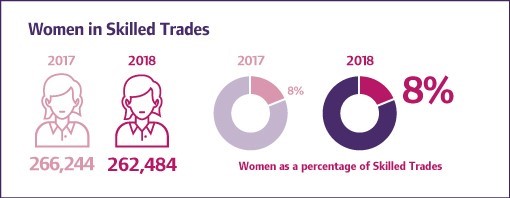
The sector is fast growing, with overall core STEM employment increasing from 2017 by 6.3%, more than 6 times that of employment overall in the UK. An increase of 44,040 women since 2017 has for the first time taken us over 900,000. However, with just under 200,000 additional men reversing 2017’s decline, there was a 0.3% drop in the percentage of women in the core STEM workforce and growth for women is 1% lower than the growth percentage for men.
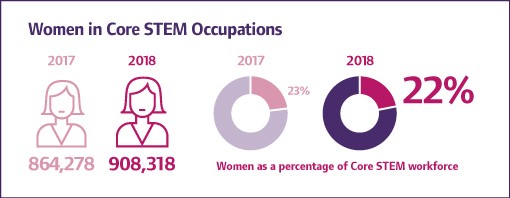
Engineering Professionals
We saw a 25% increase in the number of professional women engineers in a sector that grew 8.5% overall. Over the past 5 years, nearly 58,000 women are working as professional engineers, more than double the number there were in 2013, 5 years ago.
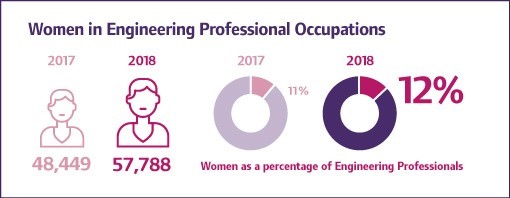
Science Professionals
Women now make up 43.2% of the total science professional workforce, but there are important differences between chemical, biological and physical sciences.
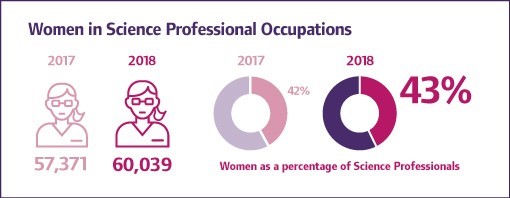
Science and Engineering Technicians
Nearly equivalent numbers of men and women (~6,000) left the science and engineering technician workforce between 2017 and 2018. As fewer women are employed in these roles, the proportional decrease in the number of women was much greater.
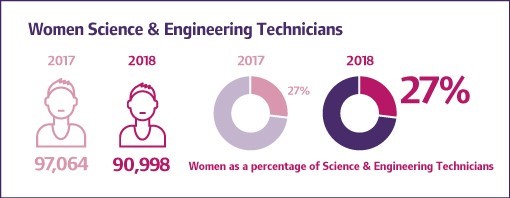
Management
The number of female managers in STEM roles has declined since 2017 (following an increase in 2017 and a large increase in 2016). However, this is entirely due to a drop in the numbers of IT/telecommunications directors. In the rest of core STEM there has been a slight overall increase.
Outside of IT, a decrease in manufacturing of 1,845 female managers has been offset by increases in construction, and mining and energy. There has also been an increase in the numbers of women working in research and development roles (of 150) at a time when male numbers have dropped (by 506), which means women now hold 41.6% of these positions.

IT Professionals
With the exception of IT/telecommunications directors, there has been an increase of 5,950 in the numbers of female specialist and project managers since 2017 even while male numbers have declined by 8,677.
The year-on-year increase in female managers is outstripped by the increase in the numbers of women working in programming/software and web development roles (17.4% and 20.3% respectively).
Although the medium-term trend shows female numbers increasing in IT professional roles, the numbers of men working in these roles are increasing at a faster rate, so the female proportion of the IT professional workforce is still only 16.2% in 2018, (14.3% in 2014).
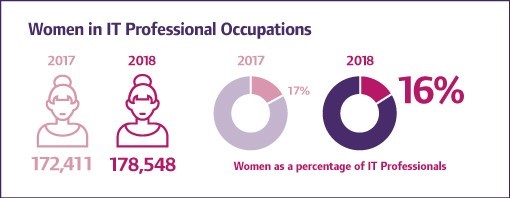
IT Technicians
The year on year female increase in total IT technician employment numbers has been almost flat while there has been an increase in the number of men of 17,500. This means the female percentage of IT technicians has dropped from 18.5% to 17.5%.
The longer-term trend shows female numbers of IT technicians declining while male numbers have increased – since 2011, there have been more than 55,000 more men brought into these roles while over 3,000 women have been lost.
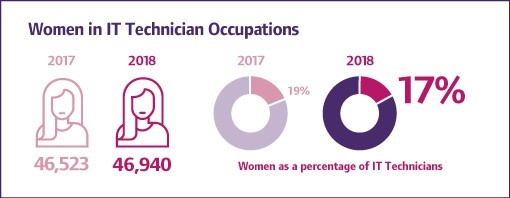
Skilled Trades
There has been a slight year-on-year drop in the number of women working in skilled trades roles of around 2,000. However, a drop in the number of men means that the female percentage of those working in these roles remains at 8%.

STEM Industries
Each year, WISE also undertakes analysis on the number of women in STEM industries***. Overall we have seen a 1% increase to 25% women in Total STEM industries from 2017.

* WISE uses the Office for National Statistics Labour Force Survey data for generating statistics on women in the UK STEM workforce. The most recent set of gender specific data was published by the ONS in September 2018. WISE reports our analysis of the number of women in STEM and core STEM occupations.
**Core STEM includes science, engineering, and information and communications technology. Health occupations are not included within the scope of core STEM. Skilled trades are not included within the scope of core STEM but WISE monitors the participation of women in skilled trades because of the scale of employment in these occupations.
A full list of occupations included in Core STEM can be found here, listed by 2010 Standard Occupational Classification (SOC) code.
***Organisations are grouped by 2007 United Kingdom Standard Industrial Classification of Economic Activities (UKSIC) code.
